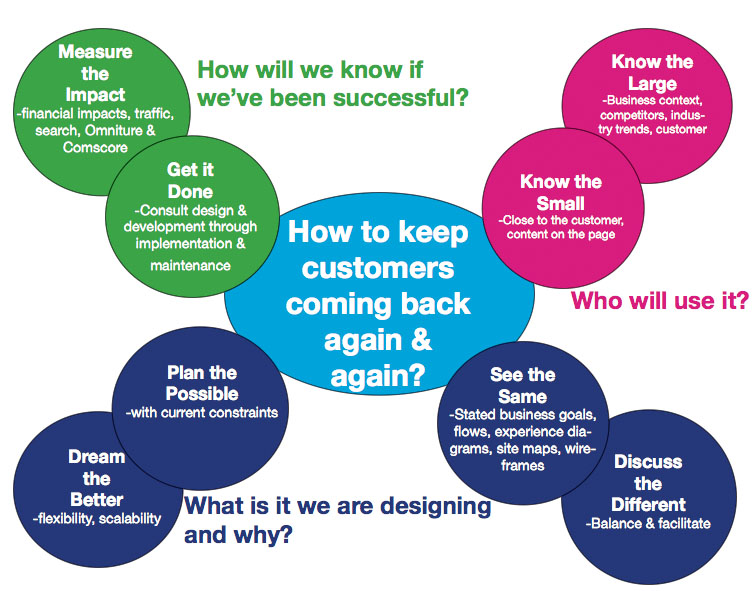This is my UX Value Mandala for User Experience or UX.

The goal of most UX is repeat customers, the core problem at the center of the diagram “How to keep customers coming back again and again?” sums this up nicely. In order to do that there are three questions that we should be asking ourselves every day:
- What is it we are designing and why?
- Who will use it?
- How will we know if we’ve been successful?
Know the Small: At the most basic level we must be very close to the customer. Do usability testing, take part in interviews, observation or ethnographic-like investigations. We also need to know the content on the page or screens. All the assets, images and video. All the features and functionalities. These two things together make up the majority of the use experience (the person interacting with the “content” through certain functionality. This is the air we breath. Through different features/functions/content we create different “settings” in which the customer has a certain experience. So if we don’t know this, we won’t know what our constraints and opportunities are.
Know the Large: This outer ring of elements are for a more senior person. More experience, knowledgeable, and built on a solid foundation of knowing the small. Knowing the Large is about the business context, the different competitors both direct and indirect, understanding trends in the industry and with customers. For example, twitter is something that 2 years ago was just starting, now it is a major force that brands need to be aware of and engage in some form.
See the Same: This is the absolute core of the value we bring to the table. If everyone just sits around a table and talks their ideas then they could walk away saying they are in agreement, but each thinking of something different. That is not sharing.. We need to create transparencies into each others minds. We find ways to make sure that everyone is “seeing the same” thing. They don’t have to like it, but they have to at least be seeing it.
Discuss the Different: After everyone is seeing the same thing then we discuss the different ideas people have. And here is where we need to be respectful of people’s ideas and listen to what they say. This takes the sharing that was established from “See the Same” and makes it an object held by joint owners. It must be owned by all. It is a difficult role sometimes, but we need to facilitate the conversation. This is both internally and with clients.
Plan the Possible: Never will we have unlimited budget or time, so we must work with what the constraints are. Actually time and money aren’t as insurmountable as lack of assets. That is the one that always is my biggest barrier.
Dream the Better: But at the same time, don’t lose those great wild ideas that you have. Record them in some fashion so that the next campaign or program can take advantage of them earlier on the process and hopeful implement some of them.
Get it Done: We can’t just be designers. We must do all we can to help get it done. This means being available for consult throughout launch and even post launch with updates and maintenance. When you have to live through multiple version of your own previous work. Scalable isn’t a buzzword anymore and flexible isn’t just nice to have.
Measure the Impact: Lastly I am a firm believer that we need to try to predict the impact of our different recommendations. We need to be watching the metrics to see if we had the impact we said we were going to realize. It might take your team awhile to get really good at this, so you might want to keep it purely internal at the start. But you will be surprised at how accurate you can become.
References and Acknowledgements”
The 3 questions come from the 1st edition of the Polar Bear book.
I want to thank Livia Labate, Crystal Kubitsky, and Austin Govella for many great conversations on the User Experience (UX) Value Mandala when I worked at Comcast Interactive Media. Also Jamie Thomson helped get the image just right in wordpress. Any errors in this post are, of course, my own.
